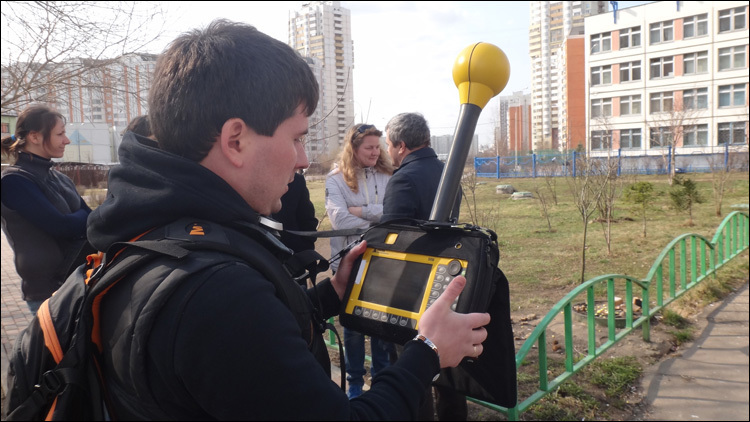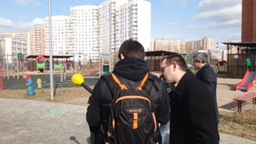Base Station Safety: Departure for Electromagnetic Density Measurement

The base station is installed on the building of the central heating center near residential buildings and the school, therefore it causes serious concern for residents and parents of students.
A cellular base station cannot just be turned on and on. To begin with, it is necessary to prepare a project with calculations of the electromagnetic field level, conduct its examination with an independent organization, establish a base station, and obtain an opinion from Rospotrebnadzor. To obtain a conclusion, measurements of the radiation intensity near the antennas and at special control points are carried out. They are carried out by experts from an independent organization. Only after receiving all the documents the base station is broadcast.
Today I will talk about how measurements of the level of radiation from this base station in a residential area of Moscow were carried out.
First, a little theory
- The main purpose of an on-site inspection is to measure the level of radiation where people are. If buildings fall in the direction of radiation, then control points are necessarily set there. Measurements are taken at the entrance to the building and inside.
- As for the choice of points in the rooms, it is important not only the height of the antennas of the base station, but also the orientation of the windows of the room in which the measurements are made, relative to the direction of radiation of the antennas.
- Elevated levels of electromagnetic fields are observed only at windows in rooms located in the immediate vicinity of the base station 0-100 m at the same height with installed antennas. This happens either in the event of a change in the urban planning situation (construction of new buildings in the immediate vicinity of the base station), or in case of non-compliance with the agreed design decisions (change of the antenna suspension height, azimuth, inclination angle).
- Most often, design decisions provide for the placement of equipment in which the levels of electromagnetic fields in places with a population stay do not exceed the maximum permissible values - 10 μW / cm 2 .
Now let's get down to practice
A specialist of the Center for Hygiene and Epidemiology in Moscow Federal State Health Institution, using a special instrument, measured radiation indicators at a distance of 15 m from the building on which the base station is located, and on the playground.

On a pedestrian walkway 15 meters from the substation building - an indicator of 0.03 μW / cm 2 with a norm of 10 μW / cm 2 The
substation is located next to the school building, so it was necessary to make measurements in classrooms on all four floors, the windows of which open onto it . The results prove that the health of schoolchildren is not in danger.

In the classroom on the 4th floor, at a distance of 0.5 m from the window, the indicator is less than 0.01 μW / cm 2 with a norm of 10 μW / cm 2 .
Measurements were taken at the kindergarten 100 meters from the base station. The results of measurements at several points on the territory and inside the building of the kindergarten proved that everything is in order - the indicators on the device are several tens of times lower than sanitary standards.

5 meters from the entrance to the kindergarten building - readings of 0.02 μW / cm 2
In conclusion and for the sake of interest, we measured the radiation level with an incoming call to the telephone of one of our employees 20 meters from the base station. We are convinced of a low radiation intensity in this case as well.

Checking radiation from the phone during a call - 0.11 μW / cm 2
The result of measurements:

With a radiation norm of 10 μW / cm 2 , the maximum recorded radiation does not exceed 0.10 μW / cm 2 .
For comparison, a microwave oven emits approximately 20-30 μW / cm 2 , depending on the model, and a home Wi-Fi router - 0.1-0.3 μW / cm 2 .
How is the base station received?
The last stage of the construction of the base station is the study of the level of the electromagnetic field. It is done like this:
- Even before the construction of the base station, the operator calculates the effect of radiation: on the basis of information about all buildings, their altitude, their purpose, special levels are used to calculate the radiation levels in horizontal and vertical planes. Based on the calculations, a project is prepared (sanitary passport).
- Then, an examination of the project by accredited organizations is done. Calculations are checked. If necessary, they may require changing the direction, location, height of the antennas, and reducing the radiation power. It turns out an expert opinion on the placement.
- Then you need the conclusion of Rospotrebnadzor for placement. Already collected documents are transferred to Rospotrebnadzor, where specialists from specialized departments study them, conduct their own expertise, and if the decision is positive, the operator receives a sanitary and epidemiological opinion on the placement of the radio transmitting facility.
- Upon completion of work, on-site measurements are taken. For this, the station is temporarily turned on for the duration of the measurement. Measurements are taken next to each antenna and at special control points around. In case of non-compliance with SanPin standards (excess), measures are taken to reduce the power of radiating antennas.
- But that is not all. Now the certified organization must verify the compliance of the project with reality. A second expert opinion is issued.
- And finally, after that, the conclusion of Rospotrebnadzor on the operation of a radio transmitting facility is issued.
What kind of device?
In this case, the Narda SRM-3006, a selective electromagnetic field meter, is a system consisting of a main module and measuring antennas for detecting electromagnetic fields and their sources in the frequency range from 9 kHz to 6 GHz.
It is used specifically for safety analysis and environmental measurements of high-frequency electromagnetic fields. The SRM-3006 covers broadcasting, mobile telephony and industrial frequencies from the low wavelength range to the latest wireless applications, and also evaluates field strengths in accordance with international or state standards.
How often are measurements taken?
Measurements are taken when the facility is commissioned. Then once every 3 years, or as the base station of the cellular communication is modernized.
Where is the technique described?
The measurement procedure is carried out taking into account the guidelines: MUK 4.3.1677-03 “Determination of the levels of the electromagnetic field generated by the radiating technical means of television, FM broadcasting and base stations of land mobile radio communications”. MUK 4.3.1167-02 “Determination of the energy flux density of the electromagnetic field in the locations of radio facilities operating in the frequency range 300 MHz - 300 GHz”.
Other posts
- Details of the radiation hazards of a base station
- Calculations for phones
